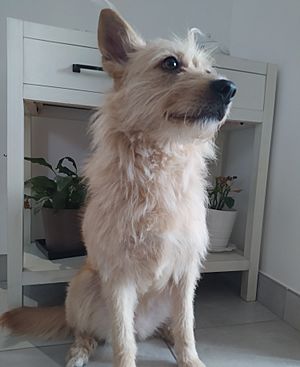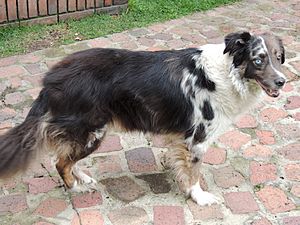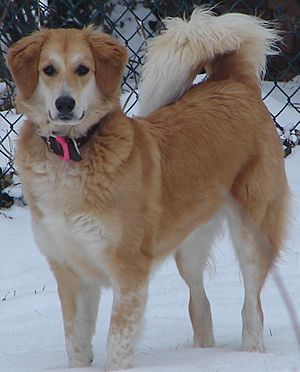Mongrel facts for kids



A mongrel, also called a mutt or mixed-breed dog, is a dog that does not belong to a single, officially recognized dog breed. These dogs are usually not the result of planned breeding.
Sometimes, people prefer the term mixed-breed dog. However, many mongrels do not have any known purebred ancestors. Dogs called crossbreeds or "designer dogs" are also a mix of breeds. But they are different from mongrels because they were bred on purpose.
Even though mongrels are not as valuable for selling as purebred dogs, many people believe they are healthier. This is because they are less likely to get genetic health problems that can come from inbreeding. Many dog lovers prefer mongrels over intentionally bred dogs. It's thought that there are about 150 million mongrels around the world!
Contents
Understanding Mixed-Breed Dogs
What's the Difference: Crossbreed vs. Mongrel?
In some places, like the United States, people often use the term mixed-breed instead of mongrel. This is because mongrel can sometimes sound negative. Some people think that mixed-breed dogs must be a mix of specific purebred dogs.
However, most purebred dogs were actually created by humans from random-bred dogs. People chose dogs with certain looks or behaviors to create new breeds. So, dogs that are not purebred are not always a mix of these specific breeds. Because of this, some experts still prefer the word mongrel.
Dog crossbreeds, also known as designer dogs, are also not part of a single recognized breed. But unlike mongrels, crossbreed dogs are usually made by people on purpose. This is called artificial selection. The word mongrel usually means dogs that developed naturally, without humans planning their parents.
Fun Names for Mixed-Breed Dogs
There are many different names for mixed-breed dogs around the world. Some words like cur or tyke can sometimes be used in a negative way. But others are just common terms. In the United Kingdom, mongrel is the official word. In North America, people often say mix or mixed-breed. Mutt is also very common in the United States and Canada.
Some places have special names for their local mixed-breed dogs:
- In Hawaii, they are called poi dogs.
- In the Bahamas and Turks and Caicos Islands, they are known as potcake dogs. This name comes from the table scraps they often eat.
- In South Africa, a funny name is pavement special.
- In the Philippines, mixed-breed street dogs are often called askal. This means "street dog" in the Tagalog language.
- In Puerto Rico, they are known as satos.
- In Brazil and the Dominican Republic, they are called vira-lata. This means "trash-can tipper" because homeless dogs might knock over trash cans to find food.
There are also some fun slang terms:
- Heinz 57 or Heinz Hound is used for dogs with unknown parents. This is a playful nod to the "57 Varieties" slogan from the H. J. Heinz Company.
- In Australia, bitsa (or bitzer) is sometimes used. It means "bits o' this, bits o' that."
Finding Out a Mixed-Breed's Family Tree
It can be hard to guess what breeds are in a mixed-breed dog, even for people who know a lot about dogs. This is because mixed-breeds have much more genetic variety than purebreds. For example, two black mixed-breed dogs might have hidden genes that could produce a blond puppy!
Since 2007, you can get DNA tests for dogs. These tests claim to find out the breed mix of a mixed-breed dog. However, these tests are still limited. They only compare your dog's DNA to a small number of known dog breeds. Also, the same breed in different places might have slightly different genetic profiles. These tests don't prove a dog is purebred. Instead, they show if your dog shares genes with certain purebreds. The American Kennel Club does not use DNA tests to decide a dog's breed.
Many newer dog breeds came from a common older breed. This makes them hard to tell apart genetically. For example, Labrador Retrievers, Flat-coated Retrievers, Chesapeake Bay Retrievers, and Newfoundland Dogs all came from the St. John's water dog. This was a natural type of dog from Newfoundland that is now extinct.
Health of Mixed-Breed Dogs
The idea of hybrid vigor suggests that mixed-breed dogs are generally healthier than purebred dogs. When purebred dogs are bred on purpose for many generations, they often get many of the same genes. Some of these genes can cause health problems. If a breed started with only a few dogs, its genetic variety might be very small for a long time.
When people choose certain dogs to create new breeds, they accidentally make more copies of certain genes. This can make the new group of dogs more fragile at first because they don't have much genetic variety. If a dog breed becomes popular and continues for hundreds of years, its genetic variety can increase over time. This is why some very old breeds are more stable.
A problem happens when traits that breeders want (like a certain look) are linked to genetic health problems. This means that breeding for that look also increases the chance of the genetic problem. Mixed-breed dogs tend to be healthier because their parents' mating is more random. This means there's less chance that both parents carry the same bad genes. However, mixing breeds doesn't guarantee perfect health. Some bad genes are found in many different breeds. If two unhealthy dogs breed, their puppies could inherit the worst traits from both parents. This is often seen in dogs from puppy mills.
Several studies have shown that mixed-breed dogs are healthier than purebred dogs.
- A German study found that "mongrels need less vet care."
- Studies in Sweden found that "Mongrel dogs are less likely to get many diseases than the average purebred dog." They also found that "mongrels were always in the low risk group" for death rates.
- Data from Denmark also suggests that mixed breeds live longer on average than purebreds.
- A British study showed similar results. However, a few purebreds (like Jack Russell Terriers, Miniature Poodles, and Whippets) lived longer than mixed breeds in that study.
One study looked at the lifespan of over 23,000 pet dogs. It found that mixed-breed dogs lived longer than purebred dogs of the same size. The average age of death was 8.5 years for all mixed-breed dogs, but only 6.7 years for all purebred dogs in the study.
In 2013, a study found that mixed breeds live about 1.2 years longer than purebreds. It also found that heavier dogs tend to live shorter lives. Another study in 2019 confirmed this 1.2-year difference in lifespan for mixed-breed dogs. It also showed that recent inbreeding can shorten a dog's life, while occasional outcrossing (breeding with a dog from a different line) can help them live longer.
Different Kinds of Mongrels
Mixed-breed dogs can be grouped into a few types:
- Mixes of known breeds: These dogs show traits of two or more specific breeds. They might have some purebred ancestors, or they might come from many generations of mixed-breeds. People often describe them by the breed they look most like, such as a "Lab mix" or "Collie-Shepherd," even if their exact family tree isn't known.
- Pariah dogs: These are wild or feral dogs that have bred naturally for many generations. The term first meant wild dogs in India. But now it refers to dogs that are part of, or came from, a group of wild or feral dogs. The Canaan Dog is an example of a recognized breed that came from pariah dogs. Pariah dogs are usually yellow to light brown and are medium-sized. This might be what the first modern dogs looked like. DNA tests show that pariah dogs have older genes than modern breeds.
- Functional breeds: These are dogs bred for specific jobs, even if their parents weren't purebred. Instead, they are chosen for how well they perform tasks. Examples include the Alaskan husky, the Eurohound, and Pointer/Greyhound mixes called Greysters. These dogs are often used in races like skijoring (skiing with dogs) in Europe. Sometimes, a functional breed like this can become an officially recognized breed over time.
Purebred dogs are known by breed names given to groups of dogs that look similar and have documented family trees. But in recent years, many owners of crossbreed dogs give them funny names. These names are often made by combining parts of the parents' breed names. These are called portmanteau names, and the dogs are called "designer dogs." For example, a mix between a Pekingese and a Poodle might be called a Pekeapoo. Another popular mix is the Goldendoodle, which is a mix of a Standard Poodle and a Golden Retriever.
Mixed-Breeds in Dog Sports
Until the early 1980s, mixed-breed dogs usually couldn't compete in obedience or other dog sports. But then, groups like the American Mixed Breed Obedience Registry (AMBOR) and the Mixed Breed Dog Clubs of America (MBDCA) started events where mixed-breed dogs could compete. Now, there are more chances for all dogs to join in sports. Most dog agility and flyball groups have always allowed mixed-breed dogs to compete. Today, mixed-breeds have proven they are great at many performance sports.
In conformation shows, dogs are judged on how well their bodies match a breed standard. Mixed-breed dogs usually cannot compete in these shows. For purebred dogs, their looks are compared to one specific breed standard. This is different for mixed-breed dogs because they can look very different from each other. They have many different physical traits like coat, bone structure, how they walk, ear shape, and eye color. When mixed-breed dogs are judged in shows (like those by the MBDCA), the rules usually focus on general traits like health, good body structure, balance, and personality.
The Kennel Club (U.K.) has a show called Scruffts. This show is only for mixed-breeds, and dogs are judged on their character, health, and personality. Some kennel clubs, which focus on promoting purebred dogs, still don't allow mixed-breeds in their events. The AKC and the FCI are two such groups. However, the AKC does allow mixed-breed dogs to earn their Canine Good Citizen award. Also, through their "Canine Partners" program, mixed-breed dogs can sign up to compete in AKC Agility, Obedience, and Rally events.
More on Mixed-Breed Health
Studies about dog health show that mixed-breeds are, on average, healthier and live longer than their purebred relatives. This is because common breeding practices for purebred dogs can reduce their genetic variety. This can also lead to physical traits that cause health problems.
Studies have also shown that mixed-breed dogs have good traits when it comes to having puppies. Researchers Scott and Fuller found that mixed-breed mothers were better than purebred mothers. They produced more milk and took better care of their puppies. These advantages led to fewer puppies dying in mixed-breed litters.
Images for kids
See also
 In Spanish: Perro mestizo para niños
In Spanish: Perro mestizo para niños









